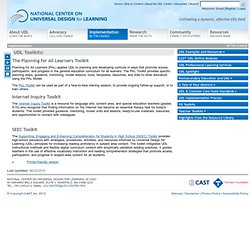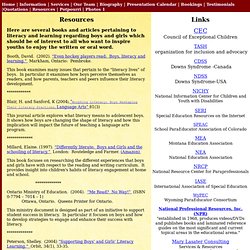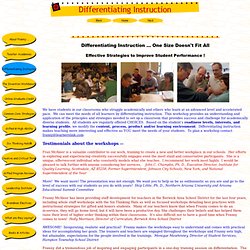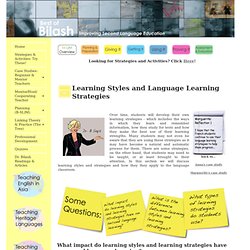

Teacher Toolkits. The Planning for All Learners Toolkit Planning for All Learners (PAL) applies UDL to planning and developing curricula in ways that promote access, participation, and progress in the general education curriculum for all learners.

The PAL Toolkit provides specific planning steps, guidance, mentoring, model lessons, tools, templates, resources, and links to other educators using the PAL Model. The PAL Toolkit can be used as part of a face-to-face training session, to provide ongoing follow-up support, or to train others. Internet Inquiry Toolkit The Internet Inquiry Toolkit is a resource for language arts, content area, and special education teachers (grades 5-10) who recognize that finding information on the Internet has become an essential literacy task for today's students. Square Graph Paper PDFs.
Marzano's Nine & 21st Century Learning Tools. Planning for and Managing Differentiation. The Differentiator. Try Respondo!

→ ← Back to Byrdseed.com The Differentiator The Differentiator is based on Bloom's Taxonomy, Kaplan and Gould's Depth and Complexity, and David Chung's product menu. Try It In: French Dutch • Tweet It • Like Byrdseed • Pin It Students will judge the ethics of the [click to edit] using a textbook and create an essay in groups of three. Revised Bloom's Taxonomy adapted from "A Taxonomy for Learning,Teaching, and Assessing: A Revision of Bloom's Taxonomy of Educational Objectives" by Anderson and Krathwohl Depth and Complexity adapted from The Flip Book by Sandra N.
Depth Big Idea Unanswered Questions Ethics Patterns Rules Language of the Discipline Essential Details Trends Complexity Multiple Points Of View Change Over Time Across the Disciplines Imperatives Origin Convergence Parallels Paradox Contribution Key Words Consequences Motivations Implications Significance Adapted from David Chung and The Flip Book, Too by Sandra N. Group Size One Two Three Four. Respondo! - Creative Literature Response Questions. Free Online Lesson Planbook Software for Teachers.
Margaret Searle.com - Searle Enterprises. School scheduling for high school middle school & elementary school students. Resources. Resources Here are several books and articles pertaining to literacy and learning regarding boys and girls which should be of interest to all who want to inspire youths to enjoy the written or oral word.

Booth, David. (2002). “Even hockey players read: Boys, literacy and learning.” Markham, Ontario: Pembroke. This book examines many issues that pertain to the “literacy lives” of boys. Blair, H. and Sanford, K (2004). This journal article explores what literacy means to adolescent boys. Millard, Elaine. (1997). This book focuses on researching the different experiences that boys and girls have with respect to the reading and writing curriculum. Ontario Ministry of Education. (2004). This ministry document is designed as part of an initiative to support student success in literacy.
Peterson, Shelley. (2004) “Supporting Boys’ and Girls’ Literacy Learning.” Smith, Michael W. and Wilhelm, Jeffrey. (2002) “Reading don’t fix no Chevys: Literacy in the lives of young men.” Links. Differentiating Instruction. Differentiating Instruction ...

One Size Doesn't Fit All Effective Strategies to Improve Student Performance ! We have students in our classrooms who struggle academically and others who learn at an advanced level and accelerated pace. We can meet the needs of all learners by differentiating instruction. This workshop provides an understanding and application of the principles and strategies needed to set up a classroom that provides success and challenge for academically diverse students. Testimonials about the workshops -- Fran McAleer is a valuable contributor to our work, training to create a new and better workplace in our schools.
Staff Presentation Library. Language Learning Strategies. What impact do learning styles and learning strategies have on second language learning?

The strategies a student uses to learn a second language depend greatly on their individual learning style. Some students are outgoing and will experiment freely and frequently while learning a new language. Other students are more introverted, preferring a more individual, private approach to the way they learn and practice the language. The strategies used by an outgoing student may vary significantly when compared with the strategies of a more reserved student. Spanish Grammar Strategies. Spanish Grammar Strategies.
The Center for Advanced Research on Language Acquisition (CARLA) Topics: Foreign Language. National Institute on Out-of-School Time. NASBE%20-%20DG_Summer%20Learning_Nov_2011. California After School Resource Center - - Resource Library.